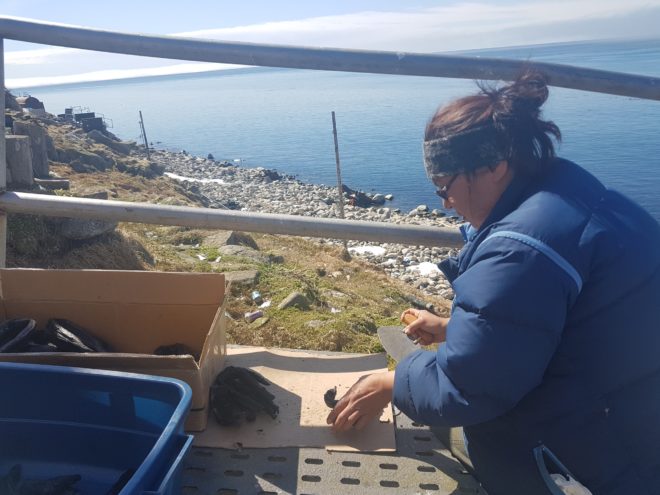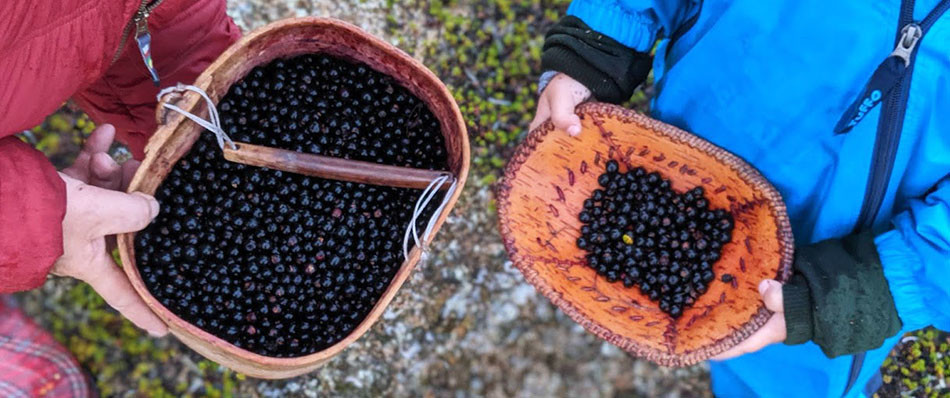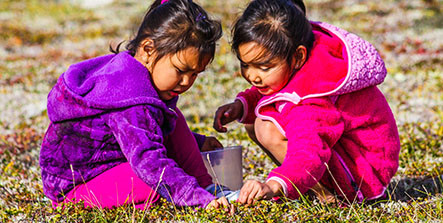
Frances Ozenna of Diomede cuts dried oogruk meat.
Traditional Teachings of Safe Food Preservation
(appeared in Kaniqsirugut News No. 70)
Foodborne botulism is nothing new to the people of northwest Alaska. Through public awareness campaigns and increased availability of the antitoxin treatment, fatalities from the life-threatening illness have been on the decline. Yet sometimes, serious cases still crop up, even when people take the steps to avoid the risks.
Recently, four family members from the Bering Strait region were diagnosed with botulism after eating aged whale flipper during a large family potluck meal. All four people experienced symptoms with differing levels of severity, and all received the antitoxin treatment at the hospital in Nome. Tragically, the treatment was not enough to save the man with the worst symptoms, and he died nearly two weeks after first arriving at the hospital for medical care.
Botulism is caused by a type of bacteria called clostridium botulinum. This bacteria occurs naturally and is commonly found throughout the environment and produces the botulism toxin. When provided the right type of conditions it needs to grow, the bacteria will grow quickly, along with the toxin. If the bacteria is allowed to grow on aging foods, the toxin can be easily consumed, and a person can be exposed to a very dangerous situation.
Because the bacteria is so commonly found in the environment, it’s important to consider the traditional methods when preparing Native foods, because the tried-and-true techniques are often the safest.
Some of the conditions that encourage the botulism bacteria to thrive are low-oxygen or no oxygen, low-acid foods (including fish and seafoods), and a certain temperature range. Traditional methods of fermenting foods outdoors in cooler weather and using natural items as storage, like underground caches, or wooden boxes and barrels, help lower the risk of bacteria growth.
For Frances “Sistuq” Ozenna in Diomede, if someone is attempting to preserve their Native food in a traditional way, the most important thing to remember is to ask for help if you’re unsure of something.
“I’ve been preparing aged Native foods for over 30 years,” she said. She still runs into uncertainty when going about fermenting traditional foods. When that happens, she says she will reach out to her father for advice.
Ozenna learned from her parents how to put away food in the customary way.
“Traditionally, preparing aged foods is taught from generation to generation within the family,” she explained. The art of preserving food differs everywhere you go, even between households in the same community.
“Their house temperature is different, the time of year is different, what they’re putting into it is different,” she said.
And these days, to further complicate things, the act of passing down knowledge is changing. Ozenna says it’s harder to teach younger generations how to do things in the traditional way because they’ve become accustomed to hearing or reading a narrative along with watching a demonstration – show and tell rather than just show and mimic. And the teachers, like herself, are not accustomed to finding the words to describe their instructions.
That may be part of the reason why modern alterations have been incorporated to the customary ways of preserving foods, and how new risks have slipped into the processes as well.
A few decades ago, it was found that there was special danger in using plastic or other non-breathable containers because they allowed the botulism bacteria to grow. Ozenna also noted the modern household is kept warmer than homes used to be kept, with sometimes just a single seal oil lamp as the heat source, and that the warmth is a factor in bacterial growth.
When Ozenna gets her hands on walrus liver, she likes to prepare for its preservation through a careful process. She first cooks it in boiled, melted snow water at medium-high until the center is pink and foamy (about 30 minutes). She leaves it in its cooked water for three days to sour (much like a sourdough starter), and then moves it to her covered porch for two weeks to sour further. After the two weeks, she rinses the meat, dries it off a little and adds it to her barrel food, containing seal oil and other preserved foods. The barrel, which is kept outdoors, will often contain seal meat, dry meat, half-dry baby walrus, bird breast, fresh coak (walrus skin and blubber) and fresh flipper, among other things.
When cooking the meat, Ozenna looks for the liver to green up a little, and if the color is off, it raises questions for her.
“I look really careful at what I’m doing,” she said. “If I have any questions inside of me, normally I would call my mom, now I can call my dad.”
If you want to get started on preserving foods, make sure to do your research. Your community’s elders might know something about the local environment that could make all the difference in your food’s safety.
Food Safety Tips from the Centers of Disease Control Prevention
-
Wash your hands, your containers and your food before you start preparing your food
This will reduce germs and will help prevent other diseases you can get from food
-
Use traditional methods when you prepare Native foods
Use methods that allow air to circulate – do not use plastic or glass containers
-
Ferment food at a cold temperature
Ideally, food should be kept below 37 degrees. It may take longer to ferment, but it will be safer
-
Boil fermented food before eating it
It might change the taste, but it will destroy the botulism poison
-
When in doubt, throw it out!
Don’t take the risk of getting sick or losing the life of a loved one. In addition, know how the food you eat is made – if you’re not sure, don’t eat it
-
Babies are more susceptible to botulism
Be sure not to feed your infant (less than 12 months old) honey because it may contain botulism spores
If you are experiencing one or more of these symptoms after consuming foods commonly associated with botulism (symptoms can appear anywhere between 6 hours to days later), you should be seen by a provider to be tested for the botulinum toxin. NSHC providers are informed about botulism and are prepared to treat it. Please note there is no quick test for botulism, and treatment is started based on symptoms and history, which is why it’s important to share as much information as possible with the medical team.
Gastrointestinal urinary system: abdominal pain, diarrhea, intestinal obstruction, nausea, urinary retention, vomiting
Neurologic system: blurry vision, decreased gag reflex, dilated or unreactive pupils, double vision, dry mouth, difficulty swallowing
Muscular system: shortness of breath (without typical signs, such as gasping), fatigue, respiratory muscle paralysis, muscle weakness
– SOA DHSS Department of Public Health


